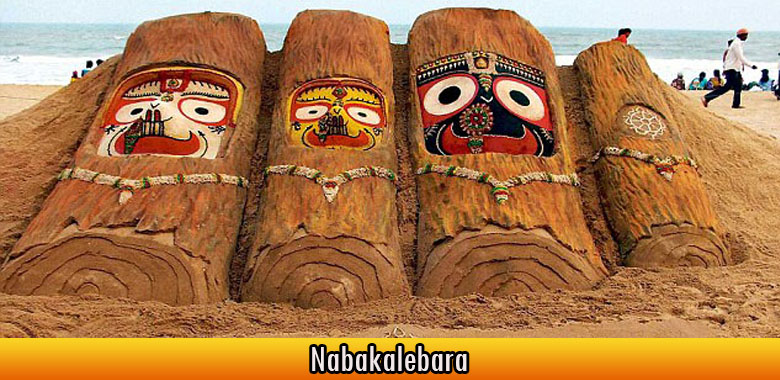Related to the car-festival, an important festival known as ‘Nava Kalebara’ is held once in every twelve to nineteen years according to the calculation of the year and date. On this occasion the wooden images of the deities are replaced by new ones. The principle adopted to fix the year of renewal is to find a year which has two full-moons in the month of Asadh (June-July). In every three years a lunar month is excluded from the calculation to keep a balance between the lunar and the solar years. This particular month, which is excluded from calculation is known as ‘Adhimasa’ or ‘Mala masa’ and is considered most inauspicious for any religious ceremony. But peculiarly enough this is considered most sacred for the renewal festival of the deities. Therefore, it is also called ‘Purusottama Masa’, as the other name of Lord Jagannath is Purusottama. During the last hundred years such festivals have been held only seven times in 1863, 1893, 1931, 1950, 1969, 1978 and 1996.
For making the new images a number of rituals connected with it are observed. When the date is fixed for the festival the Gajapati Maharajah of Puri issues a proclamation to the Vidyapati, Daitas and Brahmins well-versed in the Vedas to go in search of the trees that would provide logs for making the images. Generaly this proclamation is issued on the 10th day of the full-moon of Chaitra (March-April). After the mid-day rituals of the Lord Jagannath, the Mahapatras receive ‘Agnya mala’, the garland as a token of permission from the Lord to go in search. Then the Mahapatras carry this garland along with four Daitapatis to the ‘Anabasara pindi’ (a platform inside the temple) where they are given new garments to wear. From there they go to the Jagannath Math, the place of starting. Accompaned by the Daitapatis, Deulakarana, Tudhan, Lenka and four carpenters they go to the temple of Mangala at Kakatpur which is about forty kilometres in the north. There they sleep in the temple to obtain permission of the Goddess in dream before proceeding in four batches to four directions in search of the trees.
There are strict injunctions for selection of the trees. The trees must be of Neemba. It should have four branches and must be in near vicinity of a buried ground or river. It shouldn’t have cut marks. Snakes below the tree is an auspicious sign. Taking all these specifications into account the selection is made and the Daitapatis immediately place the garland on the trees. Then the area is cleaned. A platform is erected for Bana-yaga ceremony. Four Brahmins conduct the ritual. Then the Daitapatis sit in meditation for three days. After this the Vidyapati marks the tree with a golden axe and then the carpenters begin to cut the tree into huge logs. Thereafter the holy logs are carried in four wheeled-carts newly built for the purpose. The carts are not pulled by animals but by the Sevakas and the people. The sacred logs are taken into the temple compound through the northern gate and are placed in the Koili Baikuntha. On the day of Snana Purmina, the logs are bathed along with the aid of deities. Then the logs are carried to Darughara or the stack, and eight Brahmins perform the ritual after which the carving of the images begins by a group of carpenters. During this period nobody is allowed to visit the place. After completion of the carving, the images are painted bright in their respective colours by the traditional chitrakars. The new idols are then circumbulated for three times and brought to the Anabasarapindi for transfer of Brahma from the old deities into their new forms. The senior most among the Pal Mahapatras performs this rite at the dead hour of the night. He takes away the Brahmas from the naval zones and places them in the same position in the new forms. But, he does it blind-folded and with hands covered with clothes as he is not to see or feel the mysterious Brahmas. Then the old images are carried and buried in the wells of Koili Baikuntha by the Daitapatis. For this act they observe mourning for eleven days as is commonly done at the death of a man in a Hindu family.
Comments
comments
